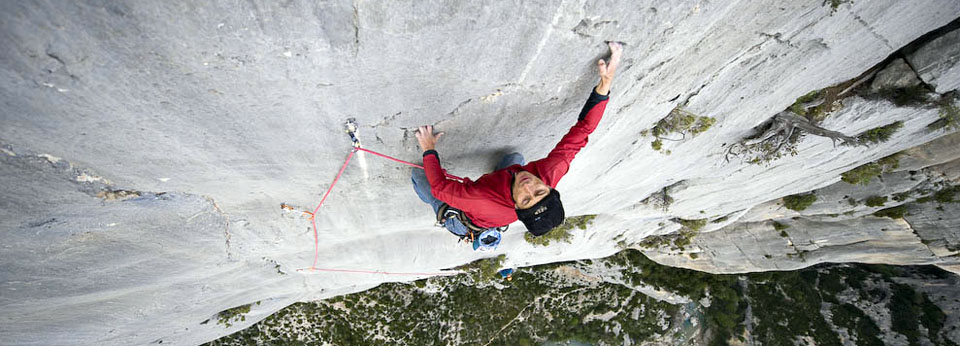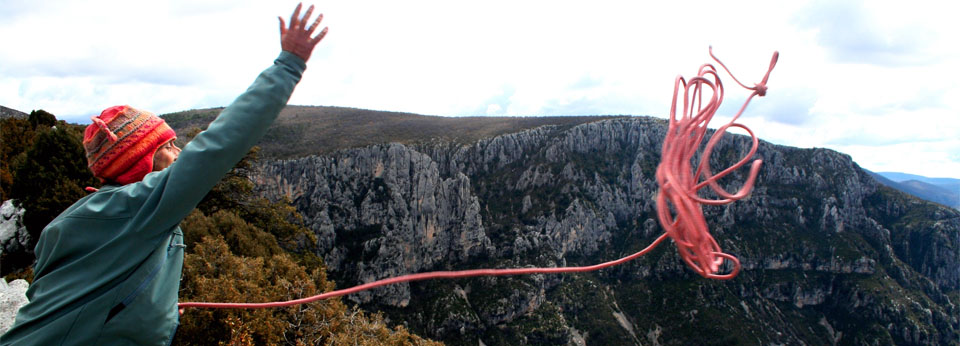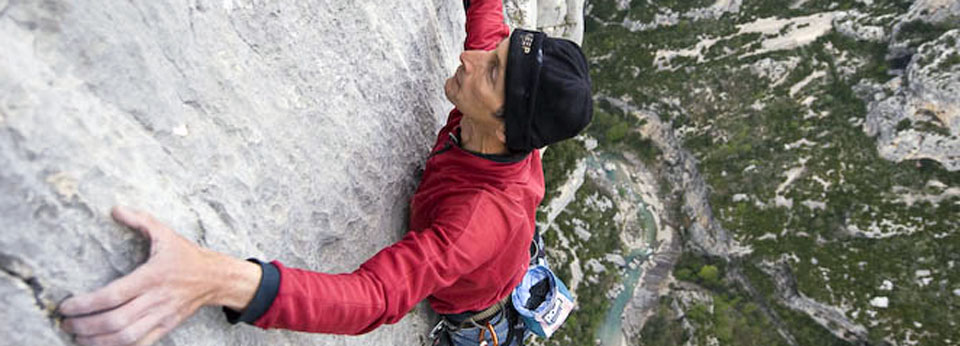In the 40 year old climbing history of the Verdon, this immortal classic stands at an historical and ethical crossroads in French and argueably world free climbing: the birth of « Rap bolting »!
By 1976 many of the great crack systems and big aid routes of L'Escales had been climbed (ground up of course!), and one might have thought the golden age of the Verdon had come to an end. Between these crack systems however were huge pillars and shields of the most perfect grey limestone yet discovered.
Though to all appearances smooth and featureless, when viewed after rain and from afar the shadows of the finely sculpted Gouttes d'eau (vertical water pockets) were apparent. It was audacious to think of venturing out onto these walls in the 'ground up' zietgiest of the early to mid 70s but Stephane Troussier and Jacques « Pschitt » Perrier did just that, traversing out of Luna Bong to establish the wildly exposed arete Necronomicon. Original, and controversial at the time « Pschitt » followed this up a year later with a true masterpiece that ushered in a new approach to the development of climbing in the Canyon. Reasoning, « Why climb new routes from the bottom with bolts, when it seems more logical to start from the top and find the best line? », then exploring and equipping using fixed ropes along the grey shield that separates Les Dalles Grises from the 3rd belvedere viewpoint, Pschitt located the intricate traversing line that would become Pichenibule, and then later Ctuluh and Gwendal.
Whether you consider him innovative and modern or a dangerous subversive, the result was a timeless classic. Even today there is a seed of doubt as one leaves the comfort of the Jardin des Ecureuils traversing out above the void of red overhangs to arrive at the point of no return below the desperate Bombé de Pichenibule. This penultimate pitch was freed by the late great Patrick Berhault in 1980 and remains a total « sandbag » 7b++! Fortunately it is equipped as an easy A0 giving access to the magnificent final 6a pitch.
Approach:
4 double rope rappels lead down Les Dalles Grises to the Jardin des Ecureuils. From here descend with care to arrive at fixed ropes leading to 3 further rappels and the base of the Canyon. Traverse left for about 200m (facing the wall) around a rock spur. Ascend slightly to attain a small ledge. The climb starts on a pillar on the far right of this.
Description:
Pitch 1 : 5c. Rock a little 'crusty' Belay in small cave on the right.
Pitch 2: 6a. Traverse right horizontally right to a small pillar and up to belay.
Pitch 3: 6a. Follow the 'old school' corner crack. Physical.
Pitch 4: 5c. Similar to the previous pitch arriving at the Jardin des Ecureuils.
Pitch 5: 5c. From the left edge of the Jardin continue as for "Afin..." traversing left past this route's belay to an isolated anchor.
Pitch 6: 5c. A superb pitch traversing horizontally along huge Gouttes d'eau to finish up a corner(slightly runout). Belay on ledge above tree.
Pitch 7: 6a+. Superb climbing on pockets. Follow diagonal line of bolts leftwards. (avoid gold coloured bolts on Agorgeamocles).
Pitch 8: 6b. A technical leftwards traverse then up a corner crack to a belay in common with "Les Rideaux de Gwendal".
Pitch 9: 6c+. 'The Business'! A long, sustained which traverses left(fingery) then follows diagonal cracks to a hard finish.
Pitch 10: 6b. Traverse left to a spectacular hanging stance at the base of the famous 'Bombe de Pichenibule'.
Pitch 11: 7b+ or A0. Easily aided to a 2 bolt anchor.
Pitch 12: 6a. Superb and runout pitch to the top.
Enjoy!
Gear: Double 50m ropes, quickdraws, small set of nuts and cams, a few slings.








